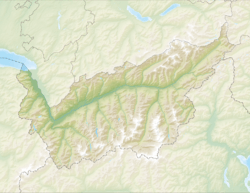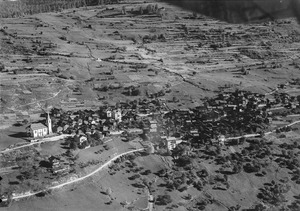Mase, Switzerland facts for kids
Quick facts for kids
Mase
|
||
|---|---|---|
|
||
| Country | Switzerland | |
| Canton | Valais | |
| District | Hérens | |
| Area | ||
| • Total | 11.1 km2 (4.3 sq mi) | |
| Elevation | 1,301 m (4,268 ft) | |
| Population | ||
| • Total | 215 | |
| • Density | 19.37/km2 (50.2/sq mi) | |
| Postal code |
1968
|
|
| Surrounded by | Nax, Saint-Martin, Vernamiège, Vex | |
Mase is a village in the Valais region of Switzerland. It used to be its own town, called a municipality. On January 1, 2011, Mase joined with two other towns, Vernamiège and Nax. Together, they formed a new, larger municipality called Mont-Noble. Mase is located in the Hérens district.
Contents
Exploring Mase's Past
Mase has a long history. It was first mentioned around the year 1100. Back then, it was known as villa Magis. For a long time, until 1902, people called it Mage.
Discovering Mase's Geography
Mase covers an area of about 11.1 square kilometers (4.3 square miles). A large part of this land is covered by forests, about 45.6%. Farms and fields make up about 36.4% of the area.
Buildings and roads take up about 3.7% of the land. A small part, 0.3%, is made up of rivers or lakes. The remaining 13.9% is land that isn't used for farming or building, like rocky areas.
The village of Mase is nestled in the Val d'Hérens. It sits on the right side of the Borgne river. It is also on the left side of the Rhone river. Mase is located at an elevation of about 1,345 meters (4,413 feet) above sea level.
Understanding Mase's Coat of Arms
The coat of arms for Mase has a special design. It shows a green pine tree growing from green hills. Next to the tree is a white chamois, which is a type of goat-antelope. At the top of the shield, there are two white stars.
Mase's Population and People
As of December 2002, Mase had a population of 215 people. Most people in Mase speak French. In 2000, about 90.3% of the population spoke French as their main language. German was the second most common language, spoken by 6.3% of the people. A small number, 1.4%, spoke Italian.
In 2008, there were slightly more females than males. About 52.3% of the population were female and 47.7% were male. Most people living in Mase were Swiss citizens.
Many residents were born right in Mase. In 2000, about 58% of the people were born there. About 17.9% were born in the same canton, Valais.
Most adults in Mase are married. In 2000, 107 people were married. There were also 73 single people and 20 widows or widowers.
The village had 99 households in 2000. About 34% of these households had only one person living in them. There were also families with children and some single-parent households.
Most buildings in Mase are single-family homes. In 2000, 81.7% of the buildings were single-family homes. Many apartments in Mase are used for holidays. About 65.1% of apartments were used seasonally.
The chart below shows how Mase's population has changed over the years:

Important Sights in Mase
The entire village of Mase is recognized as an important cultural site. It is part of the Inventory of Swiss Heritage Sites. This means its buildings and layout are protected because of their historical value.
Mase's Economy and Jobs
In 2008, there were 36 full-time jobs in Mase. Four of these jobs were in farming. Fourteen jobs were in construction, like building houses. The service industry, which includes hotels and restaurants, had 18 jobs. Most of these, 13 jobs, were in hotels or restaurants.
Many people who live in Mase work outside the village. In 2000, 61 workers traveled out of Mase for their jobs. Only 7 workers came into Mase to work. This means more people leave Mase for work than come in.
Religious Life in Mase
According to the 2000 census, most people in Mase are Roman Catholic. About 84.5% of the population followed this religion. A smaller group, 3.9%, belonged to the Swiss Reformed Church. About 2.42% of the population were Islamic. Some people, about 5.31%, did not belong to any church.
Education in Mase
Many adults in Mase have completed a good level of education. About 31.9% of the population finished upper secondary education. This is like high school. About 4.8% went on to get a higher education degree. This means they attended a university or a specialized college.
In 2000, 25 students from Mase went to schools outside the village.
See also
 In Spanish: Mase (Valais) para niños
In Spanish: Mase (Valais) para niños






